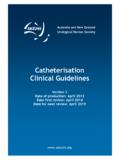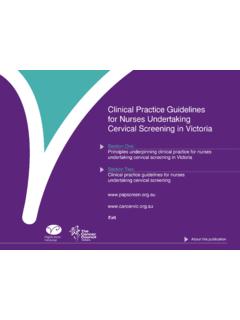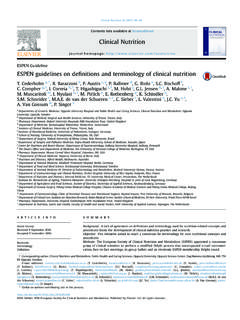Transcription of Appendix I Materials for Clinical Application of …
1 Long-Term Follow-Up guidelines for Survivors of Childhood, Adolescent, and Young Adult Cancers Version October 2008. Appendix I. Materials for Clinical Application of LTFU guidelines Copyright 2008 Children's Oncology Group All rights reserved worldwide Children's Oncology Group Long-Term Follow-Up guidelines for Survivors of Childhood, Adolescent, and Young Adult Cancers Version October 2008. Materials for Clinical Application of the COG LTFU guidelines Appendix 1 Content Reference Materials - Abbreviations - Chemotherapy Agents Summary of Cancer Treatment - Instructions - Summary Form Template - Abbreviated - Summary Form Template - Comprehensive - Summary Form Key Patient-Specific Guideline Identification Tool - Instructions - Patient-Specific Guideline Identification Tool Radiation Reference Guide - Instructions - Dose Calculation Examples - Radiation Fields Defined - Radiation Diagrams By Anatomic Location By Guideline Section Number - Relevant Guideline Sections by Radiation Exposure Health Link Index by Section Number Appendix 1.
2 Content Long-Term Follow-Up guidelines for Survivors of Childhood, Adolescent, and Young Adult Cancers Version October 2008. Reference Materials Copyright 2008 Children's Oncology Group All rights reserved worldwide Abbreviations Abbreviation Definition AAP-CIDP American Academy of Pediatrics Committee on Infectious Disease Prevention ABR Brainstem auditory evoked responses AFP Alpha fetoprotein ACS American Cancer Society AHA American Heart Association ALT Alanine aminotransferase AST Aspartate aminotransferase ATM Ataxia telangiectasia cancer susceptibility gene located on chromosome 11. AVN Avascular necrosis BAER Brainstem auditory evoked responses BCNU Carmustine BMD Bone mineral density BMI Body mass index BRCA1 Breast cancer, early onset gene (cancer susceptibility gene located on chromosome 17).
3 BRCA2 Breast cancer 2, early onset gene (cancer susceptibility gene located on chromosome 13). BUN Blood urea nitrogen Ca Calcium CBC Complete blood count CCG Children's Cancer Group CCNU Lomustine CD-4 Cluster of differentiation antigen associated with helper T lymphocyte CDC Centers for Disease Control cGVHD Chronic graft versus host disease Cl Chloride CNS Central nervous system CO2 Carbon dioxide COG Children's Oncology Group CSF Cerebral spinal fluid CT Computed tomography CXR Chest radiograph DES Diethylstilbestrol DEXA Dual energy x-ray absorptiometry DLCO Diffusion capacity of carbon monoxide DOE Dyspnea on exertion EBMT European Group for Blood and Marrow Transplant ECHO Echocardiogram EKG Electrocardiogram EIA Enzyme immunoassay FAP Familial adenomatous polyposis FNA Fine needle
4 Aspirate FSH Follicle stimulating hormone GH Growth hormone GVHD Graft versus host disease Gy Gray HBcAb Hepatitis B core antibody HBsAg Hepatitis B surface antigen HCT Hematopoietic cell transplant HCV Hepatitis C virus HDL High-density lipoproteins HIB Haemophilus influenza B. HIV Human immunodeficiency virus Abbreviations Page 1. Abbreviations (cont). Abbreviation Definition HNPCC Hereditary nonpolyposis colorectal cancer HPF High power field HPV Human papilloma virus HRT Hormonal replacement therapy Hz Hertz IBD Inflammatory bowel disease K Potassium I-131 Iodine 131 radioisotope IQ Intelligence quotient IT Intrathecal IV Intravenous IVIG Intravenous immunoglobulin KUB Kidneys, ureters, bladder radiograph LH Luteinizing hormone MIBG Iodine-131-meta-iodobenzylguanidine Mg Magnesium MOPP Mechlorethamine, Oncovin, Procarbazine, Prednisone MRI Magnetic resonance imaging MUGA Multiple Gated Acquisition scan Na Sodium NCEP National Cholesterol Education Program NCHS National Center for Health Statistics NF1 Neurofibromin 1 (neurofibromatosis)
5 Cancer susceptibility gene located on chromosome 17. NSAIDs Non-steroidal anti-inflammatory drugs OAE Otoacustic emissions OCP Oral contraceptive pills PAP Papanicoulau PCR Polymerase chain reaction PFTs Pulmonary function tests p53 Cancer susceptibility gene located on chromosome 17 associated with familial cancers PO By mouth PO4 Phosphate PRN As needed PSA Prostate specific antigen QCT Quantitative computed tomography QTc Corrected QT interval RB1 Retinoblastoma gene cancer susceptibility gene located on chromosome 13. RBC Red blood cell RDA Recommended daily allowance RUQ Right upper quadrant SCUBA Self-contained underwater breathing apparatus SD Standard deviation SOB Shortness of breath T4 Thyroxine TBI Total body irradiation TPN Total parenteral nutrition TSH Thyroid stimulating hormone U/A Urinalysis USPSTF United States Preventive Services Task Force VOD Veno-occlusive disease VZIG Varicella zoster immunoglobulin Abbreviations Page 2.
6 Chemotherapy Agents Generic Name Additional Name(s) Classification Asparaginase Elspar Enzyme Erwinia asparaginase Kidrolase . L-asparaginase Oncaspar . PEG-asparaginase Bleomycin Blenoxane Anti-tumor antibiotic Busulfan Busulfex Alkylating agent Busulphan Myleran . Carboplatin CBDCA Heavy metal Paraplatin . Carmustine BCNU Alkylating agent BiCNU . Chlorambucil Leukeran Alkylating agent Cisplatin CDDP Heavy metal Cisplatinum Platinol . Cyclophosphamide CPM Alkylating agent Cytoxan . Neosar . Procytox . Cytarabine Ara-C Antimetabolite Cytosar . Cytosar-U . Cytosine arabinoside Dacarbazine DTIC Non-classical alkylator DTIC-Dome . Dactinomycin Actinomycin-D Anti-tumor antibiotic Cosmegen . Daunorubicin Cerubidine Anthracycline antibiotic Daunomycin DaunoXome.
7 Dexamethasone Decadron Corticosteroid Doxorubicin Adriamycin Anthracycline antibiotic Doxil . Rubex . Epirubicin Ellence Anthracycline antibiotic Pharmorubicin PFS . Chemotherapy Agents Page 1. Chemotherapy Agents (cont). Generic Name Additional Name(s) Classification Etoposide VePesid Epipodophyllotoxin VP-16. Idarubicin Idamycin Anthracycline antibiotic Ifosfamide Ifex Alkylating agent Lomustine CeeNU Alkylating agent CCNU. Mechlorethamine Mustargen Alkylating agent Nitrogen Mustard Melphalan Alkeran Alkylating agent Mercaptopurine 6-Mercaptopurine Antimetabolite 6-MP. Purinethol . Methotextrate Amethopterin Antimetabolite Folex . Mexate . Trexall . Mitoxantrone Novantrone Anthracycline antibiotic Prednisone Deltasone Corticosteroid Methylprednisolone Prednisolone Procarbazine Matulane Alkylating agent Natulan.
8 Temozolomide Temodal Non-classical alkylator Temodar . Teniposide VM-26 Epipodophyllotoxin Vumon . Thioguanine Lanvis Antimetabolite Tabloid . 6-Thioguanine 6-TG. Thiotepa Thioplex Alkylating agent Vinblastine VBL Plant alkaloid Velban . Velbe . Vincristine Oncovin Plant alkaloid VCR. Vincasar . Vincrex . Chemotherapy Agents Page 2. Long-Term Follow-Up guidelines for Survivors of Childhood, Adolescent, and Young Adult Cancers Version October 2008. Summary of Cancer Treatment Copyright 2008 Children's Oncology Group All rights reserved worldwide Summary of Cancer Treatment - Instructions Importance of a Comprehensive Cancer Treatment Summary The Children's Oncology Group Long-Term Follow-Up guidelines for Survivors of Childhood, Adolescent, and Young Adult Cancers are based on therapeutic exposures received during cancer treatment.
9 Availability of a comprehensive treatment summary, including all therapeutic agents received by the survivor, is presumed. Patients who do not have a comprehensive treatment summary should be instructed to obtain one from the institution(s) where they received their treatment. Ideally, the comprehensive treatment summary should include the following information: Demographics (name, sex, date of birth, contact information). Diagnosis, including site/stage, date, and relapse(s) if any Pertinent secondary diagnoses ( , second malignancy, Down syndrome). Treatment protocol information, if applicable All chemotherapy agents received during treatment (including route of administration for all agents, cumulative doses for alkylators, bleomycin, and anthracyclines, and designation of high dose versus standard dose for methotrexate and cytarabine).
10 Cumulative doses for all other agents should be provided if available. Note: High dose methotrexate/cytarabine is defined as any single dose >1000 mg/m2. Standard dose methotrexate/cytarabine is defined as all single doses <1000 mg/m2. See section 28 of guidelines for anthracycline isotoxic dose-equivalent conversion. For doses in mg/kg, multiply by 30 to obtain equivalent dosing in mg/m2 (example: 2 mg/kg = 60 mg/m2). Radiation therapy summary, including field(s), laterality (if applicable), start/stop dates, number of fractions, dose per fraction, boost dose/location (if applicable), total dose (in Gy), and radiation type. Note: To convert cGy or rads to Gy, divide dose by 100 (example: 2400 cGy = 2400 rads = 24 Gy); for definition of radiation fields, see page 6 of the Radiation Reference Guide ( Appendix 1).










